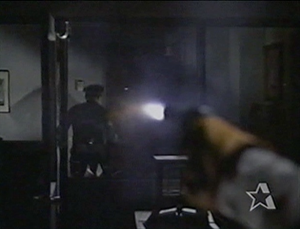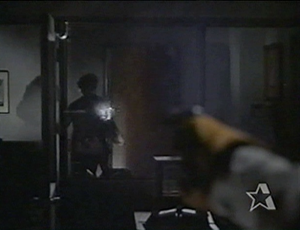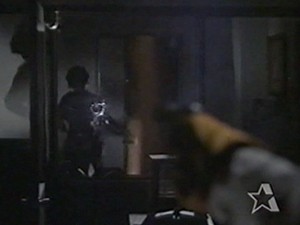Filmed August 1966
Legendary art director William Cameron Menzies invented the job title, Production Designer, after his work on GONE WITH THE WIND. It denoted contribution beyond the creation of the sets for a film. I bring this up because during the prep period for ORDEAL, my next assignment on THE FBI, art director Richard Haman came to me with a plan for the opening sequence. He had worked out the mechanics for the shooting of the guard – the precise placement of the camera and the gun so that the hole created in the glass pane by the shattering pellet would be in line with the guard’s body. But the pellet would go off to the side, avoiding any injury to the actor portraying the guard.
To show how precise Haman’s planning was, here are sequential stills of the firing:



That to me was an example of a contribution of a production designer.
Another callous cold-blooded killing like in THE PLUNDERERS, but I wanted this one to be more dramatically effective than what I considered my ineffectual staging of that previous effort. The bloodletting of BONNIE AND CLYDE was still a year in the future, although for television it would be much beyond that. And there was the network double standard to contend with. Network programming loved violence, but network program practices had many restrictions. You couldn’t make death ugly by showing the massive bloody wound created by a bullet. That would offend the public. A bullet hole would rarely be a blood spot as large as a quarter. I remembered a foreign film starring Anna Magnani in which a bullfight was never seen; it was shown only by her reaction in a prolonged closeup. And that’s what I decided to do; rather than film Kingsley being shot, I would focus on Dave’s reaction to the killing. That had the advantage of adding dimension to the character of the person reacting, in this case Paul Bryar (now off Quinn Martin’s don’t-use-list), birth name Gabriel Paul Barrere, and known and beloved by all who knew him as Gaby. I had met Gaby and his wife, Claudia, in 1955 when they auditioned for a production of the play, MY THREE ANGELS I was to direct. They both ended up appearing in that play, and the following year we joined forces when they played Willy and Linda Loman in my production of DEATH OF A SALESMAN, with a very young Dick Sargent as their son Biff. They were the beginning of my west coast family, an extension of the blood family I already had.
There was a scene where Erskine and Rhodes interviewed the landlady of the rooming house where a missing driver lived. In the script his room was described as messy, so I saw a chance to do more than a simple question and answer scene. I had the actress cast in the part play it in a more distraught manner. She was upset at the mess in the room and kept moving around, picking up articles of clothing during the questioning by Erskine and Rhodes. I thought it added dimension and humor to the scene. Quinn didn’t. He thought it was too frivolous, so I ended up reshooting the scene with a different actress and this time they just stood and talked.
Gerry O’Loughlin didn’t look like an actor, he didn’t sound like an actor. He wasn’t too tall, was stocky and he spoke with a definite east coast rhythm. But he was like Cagney, a cauldron of constantly seething emotions, which he wasn’t afraid to unleash. And he was a wonderfully trained actor. A member of the famed Actor’s Studio, nothing but the truth emanated from him. This was the first of four times that we would work together.
I’m quite certain if the barn sequences were being filmed today, they would all be done on location. Quinn Martin still adhered to the old studio principles. The exterior of the barn and the entrances and exits into the barn were shot on location, but the long scenes in the barn were filmed on a sound stage where Billy Spencer could work his photographic magic.
ORDEAL was the ninth time I worked with Stephen Brooks, the seventh time we collaborated on THE FBI. It was the first time we worked together that his character of Rhodes was given anything to do beyond trailing along with Erskine in a subsidiary role. When the series began Rhodes had been involved romantically with Erskine’s daughter. There was a subplot that extended for several episodes when Erskine was opposed to their approaching marriage; he didn’t want his daughter marrying an FBI agent. But then that story line along with the daughter played by Lynn Loring quietly disappeared and Rhodes’ involvement in plots noticeably shrank. That was about to change.
The script may have been based on a case out of the FBI files, but I will admit that I was influenced by the wonderful French film, WAGES OF FEAR.
I’ve already written about the conflict with sponsor Ford over the use of an armored car in THE PLUNDERERS. Ford didn’t produce an armored car and the ad agency representative wanted us to substitute a panel truck. We won that battle and used an armored car produced by someone else. We were not so lucky on the current show. The final leg of the journey in our script included a fierce storm in mountainous terrain as the truck picked this unfortunate time to have brake problems. At the weekly production meeting attended by Tom, the agency representative for Ford, he told us that that was unacceptable. Since the truck carrying the nitro was a Ford, sponsor Ford was not about to show one of their prized vehicles in an unfavorable light. In plain words Ford did not produce trucks that developed brake problems. Our problem was that we needed a final exciting, hair-raising climax in our final act. The original script detailed the truck, on a long stretch of highway under construction, carefully traveling over potholes and road obstructions on its downgrade descent during a heavy storm. When its brakes gave out, the truck started a wild careening trip down the mountain downgrade. I would have had Carl desperately trying to control the vehicle, his foot furiously pumping the brake pedal, but that was no longer an option. Our solution to the problem? I filmed everything except the foot on the brake.
ORDEAL was the second time I worked with George Wallace, who played Lockwood. The first time was many years before, when I directed him in a musical industrial stage show for Westinghouse (I think) for one of their conventions in Las Vegas. George had a long career in movies and film without ever gaining the stardom he achieved on Broadway in NEW GIRL IN TOWN with Gwen Verdon, JENNIE with Mary Martin, PIPE DREAM with Helen Traubel and other musicals, THE PAGAMA GAME, THE MOST HAPPY FELLA, COMPANY, FUNNY GIRL and KISS ME KATE.
Steve Brooks left THE FBI at the end of the second season and for years I assumed he had left the series because of the limited opportunities the role of Rhodes gave him. Only recently did I do some limited research and discover he did not leave of his own volition. I was not able to find out who was responsible or the reason for his dismissal. I directed Steve the following year in the most notable of our collaborations, OBSESSION on STAR TREK. And then our paths didn’t cross. In the early seventies Eleanor at the Toluca Lake barber shop we both patronized told me he was an unhappy disturbed young man. Later he left Hollywood and moved to Seattle. Since beginning my original blog two years ago I received a communication from a viewer up there who had met Steve and again described him as being disturbed and unhappy:
Mr. Senensky, thank you very much for your message.
Your story are very interesting!!!
I knew Mr Brooks in 1998 in Seattle. I met him at the Volunteers Park only for two hours I think and we talked. I remembered of him because I watched “The interns” when I was Young. It’s a long story. Then, when I came back home I received a post card from him. He was not very good. He was alone, so thin and I supposed he was drinking a lot.
His story is very sad. He was found dead in his apartment and died for a brain aneurism.
The world is very very small.
Thank you for your attention
He died in 1999 at the age of 57 of a massive heart attack, an attractive, gifted performer who was truly a victim of Hollywood.
The journey continues



The 9th video prompted my Dad and I to scream “Slow Down!” to Munger. Omitting the brake pumping hurt the scene. I wonder if this option crossed the mind of the Ford Motor Co. rep: “We’ll use a GMC truck for the episode…so what if its brakes fail?!”
In an ep. of ‘Judd for the Defense’, Gerry O. played his Working Man role to the hilt as a longshoreman trying to get justice from his corrupt union shop steward.
Ralph, where were the exteriors scenes of the boarding house (4th video) and Carl’s house (5th video) done? Also, how about the miscellaneous outdoor locations for the truck? Thanks.
Regarding the brake pumping: we were instructed that Ford trucks did not have brake problems. But without the fast race downhill, there was no drama. What Ford was thinking — if I were a mind reader I couldn’t figure that one out.
For Clip #4: I don’t remember. Some LA neighborhood.
For Clip #5: Some where in Burbank
Ralph, I’ve been re-watching THE FBI; now in Season Two and enjoying “Ordeal.” Directors must be tickled to work with great “faces” like O’Laughlin, Bryar, and Wallace. Little wonder these and many other character players worked all the time–their professionalism was priceless, and show runners knew precisely which qualities they’d bring to a show. Very pleased to see a favorite actress, Jacqueline Scott, in “Ordeal.” You and your DP put together a wonderfully effective extreme closeup on Scott’s face, as she and O’Laughlin embrace, and he tells her that he’s finally landed a job. Scott’s facial expressions and long moment of silence are superb, a strong example of a rewarding collaboration of actor and director. Lovely shadowplay in this episode, including the interior of the O’Laughlin-Scott house–a “typical” sort of home that’s also fraught with tension that we can absorb subliminally from those shadows, as well as via plot and dialogue. Finally, I’ll add my own praise for Stephen Brooks, an intelligent, amiable presence who had a nice opportunity to stretch as an actor in “Ordeal.” I regret that he wasn’t a happier man. Your blog needs to be in book form; it’s invaluable oral history.